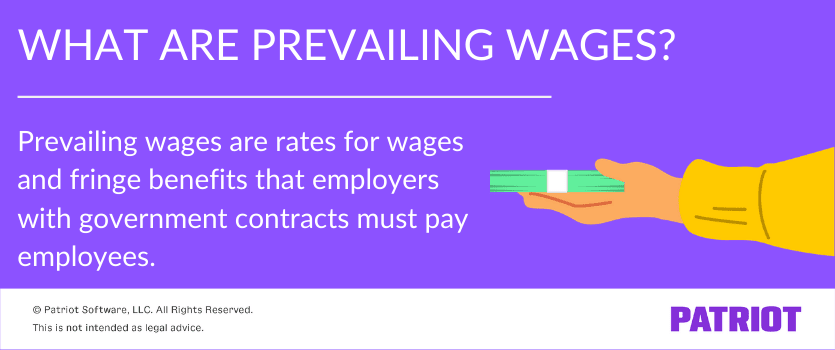Most business owners are familiar with their minimum wage responsibilities. But if you take on a federal or state government contract, you also need to know about prevailing wages. What are prevailing wages?
Prevailing wage definition:
Prevailing wages are rates for wages and fringe benefits set by the Department of Labor (DOL) that employers with government contracts or foreign workers must pay their employees. The prevailing wage rates vary by location and are based on the average wages employees with similar roles receive in the area. Employers who take on federal contracts must pay the rate. Many states also have laws requiring employers who take on state contracts to pay the prevailing wage rate.

The Davis-Bacon and Related Acts established the prevailing wage for federal contracts. State law names may vary, but many share the title of Little Davis-Bacon Act.
Under the Davis-Bacon and Related Acts, you must pay employees the prevailing wage if you have a federal contract over $2,000. States with a prevailing wage law have different thresholds that vary from $0 – $1,000,000.
In short, you must pay employees the prevailing wages if you have:
- A federal contract in excess of $2,000
- A state contract that meets your state’s prevailing wage law (if applicable)
- Foreign workers in an employment-based visa program involving the DOL
Prevailing wage determination by state
You know that the threshold for federal contracts is $2,000, meaning that if your contract is more than $2,000, you must pay employees the prevailing wage. But what about state contracts?
A little over half of the states have a prevailing wage law. So, how much does your state public works contract need to be worth for the prevailing wage law to apply to you? Take a look at the following chart to find out.
| State | Prevailing Wage Threshold |
| Alaska | $25,000 |
| California | $1,000 $25,000 for construction work or $15,000 for qualifying alteration, demolition, repair, or maintenance |
| Connecticut | $1,000,000 (new construction) $100,000 (remodeling) |
| Delaware | $500,000 (new construction) $45,000 (alteration, repair, renovation, rehabilitation, demolition, or reconstruction) |
| Hawaii | $2,000 |
| Illinois | None |
| Maine | $50,000 |
| Maryland | $500,000 (for qualifying circumstances) |
| Massachusetts | None |
| Minnesota | $25,000 (more than one trade) $2,500 (one trade) |
| Missouri | $75,000 |
| Montana | $25,000 |
| Nebraska | None |
| Nevada | $100,000 |
| New Jersey | $2,000 – $50,000 (situational) |
| New Mexico | $60,000 |
| New York | None |
| Ohio | $78,258 or $250,000 (new construction, depending on type of work) $23,447 or $75,000 (remodeling, depending on type of work) Some types of construction are exempt |
| Oregon | $50,000 (major renovations) $750,000 (any project) |
| Pennsylvania | $25,000 |
| Rhode Island | $1,000 |
| Tennessee | $50,000 (highway construction) None (all others) |
| Texas | None |
| Vermont | $100,000 OR at least 50% funded by a capital construction act costing more than $200,000 |
| Washington | $25,000 (construction on state colleges/universities) None (all other) |
| Washington D.C. | $100,000 |
| Wyoming | $100,000 |
Contact your state for specifics relating to its prevailing wage law.
Nearly half of the states do not have laws in place to regulate prevailing wages at the state level. The following states do not have prevailing wage laws:
| Alabama | Idaho | Michigan | South Carolina |
| Arizona | Indiana | Mississippi | South Dakota |
| Arkansas | Iowa | New Hampshire | Utah |
| Colorado | Kansas | North Carolina | Virginia |
| Florida | Kentucky | North Dakota | West Virginia |
| Georgia | Louisiana | Oklahoma | Wisconsin |
OK, but what are the prevailing wage rates?
Now that you know whether your contract falls under federal or state prevailing wage law, you probably want to know what the heck the rate is.
To find out the prevailing wage you must pay employees, use the DOL’s Wage Determination On Line (WDOL) website. This website provides general wage determinations by area. In some cases, this may be enough for your project.
However, the agency your government contract is through may need to obtain a specific wage determination through the Department of Labor. If the government agency does contact the DOL, the DOL’s Wage and Hour Division (WHD) conducts a survey to determine the prevailing wage rate. The government agency then includes the prevailing wage in your contract.
So, what does a survey conducted by the DOL look like? Take a look at the steps involved in a DOL wage determination survey:
- Determining survey parameters: A WHD regional office decides how they’ll gather wage averages by looking at the area, type of construction, and time frame
- Obtaining project list: The regional office reviews reports that detail construction type, expected duration, prime contractor, and project value
- Conducting pre-survey briefings: The regional office conducts local meetings to explain the survey process to contractors and other parties
- Notifying contractors and parties: Contractors receive letters detailing the survey parameters and pre-survey briefings information
- Collecting and analyzing data: The regional office analyzes the information about the job details to determine prevailing wages
- Publishing findings: The national WHD office analyzes and reviews survey findings
For more information on the survey process, check out the DOL’s website.
Looking for a way to run payroll for your employees? You’ve come to the right place. Patriot’s online payroll makes it easy to run payroll in three steps, offers U.S.-based support (for free), and comes highly recommended from employers like you. Start your free trial now!
This article has been updated from its original publication date of April 20, 2012.
This is not intended as legal advice; for more information, please click here.